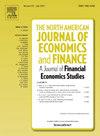级联失效、金融网络与系统性风险
IF 3.9
3区 经济学
Q1 BUSINESS, FINANCE
North American Journal of Economics and Finance
Pub Date : 2025-07-20
DOI:10.1016/j.najef.2025.102505
引用次数: 0
摘要
如何准确地度量系统性风险是风险管理领域的基础性和挑战性问题之一。以往的研究大多没有充分考虑风险共传染和网络效应导致的级联失效机制,导致对系统性风险的错误估计。利用LASSO技术构建金融机构尾部风险网络,并利用ΔCoES在网络上模拟风险传染的级联过程。通过建立一个通用的级联失效模型,本文提出了一个新的指标ESRank来衡量系统性风险。我们运用ESRank对中国金融机构进行分析,实证结果表明:(1)在危机时期,特别是2015-2016年股灾时期,中国金融体系的ESRank高于正常时期;(2)股灾前证券行业是最大的风险贡献者,股灾后多元化金融机构的风险贡献呈上升趋势;(iii)与传统的系统风险指标VaR、CoVaR和SRISK相比,所提出的ESRank对机构盈利能力具有更好的预测和解释能力。本文章由计算机程序翻译,如有差异,请以英文原文为准。
Cascading failure, financial network and systemic risk
How to accurately measure the systemic risk is one of the fundamental and challenging problems in the field of risk management. Most previous studies do not fully consider the cascading failure mechanism caused by risk co-contagion and network effects, leading to misestimation of systemic risk. We construct financial institution tail risk networks by LASSO technique and then simulating the cascading process of risk contagion by ΔCoES on the networks. By developing a general cascading failure model, this paper proposes a novel indicator, ESRank, to measure systemic risk. We apply ESRank to analyze Chinese financial institutions and the empirical results suggest that: (i) during the crisis periods, especially the 2015–2016 stock crash period, the Chinese financial system manifests a higher ESRank in comparison to normal periods; (ii) the securities sector is the largest risk contributor before the stock crash, while the diversified financial institutions have displayed increasing risk contributions afterwards; (iii) compared with the traditional systemic risk indicators such as VaR, CoVaR and SRISK, the proposed ESRank demonstrates the outstanding characteristics of better predictive and explanatory capabilities regarding institutional profitability.
求助全文
通过发布文献求助,成功后即可免费获取论文全文。
去求助
来源期刊
CiteScore
7.30
自引率
8.30%
发文量
168
期刊介绍:
The focus of the North-American Journal of Economics and Finance is on the economics of integration of goods, services, financial markets, at both regional and global levels with the role of economic policy in that process playing an important role. Both theoretical and empirical papers are welcome. Empirical and policy-related papers that rely on data and the experiences of countries outside North America are also welcome. Papers should offer concrete lessons about the ongoing process of globalization, or policy implications about how governments, domestic or international institutions, can improve the coordination of their activities. Empirical analysis should be capable of replication. Authors of accepted papers will be encouraged to supply data and computer programs.

 求助内容:
求助内容: 应助结果提醒方式:
应助结果提醒方式:


